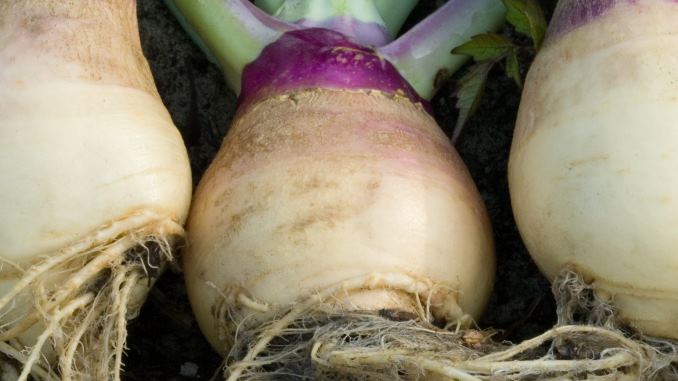The variety of vegetables in a supermarket can be astounding. In particular, many people are often confused about two types of tubers: jicama vs rutabaga.
Although both belong to the Brassica family, they have entirely different characteristics, such as taste, texture, or cooking method. The following article will help you distinguish these two types of root vegetables.
Quick Facts
Jicama
- Taste and texture: sweet
- Appearance: brown skin, white flesh
- Nutritional value: higher fiber
- Cooking method: raw or cooked
Rutabaga
- Taste and texture: sweet, pungent, and slight bitterness
- Appearance: purple, brown, or golden brown skin, yellow or orange flesh
- Nutritional value: higher sugar, calcium, potassium, phosphorus
- Cooking method: cooked
Similarities Between Jicama & Rutabaga
Both root vegetables have the same feature: they belong to the Brassica family, including broccoli, cabbage, cabbage, and kohlrabi. Moreover:
- Jicama is similar to a potato, which is a starchy root vegetable. The root is sweet but low in sugar, making it an excellent choice for diabetes and those on a low-sugar diet.
- Rutabaga is also a plant that brings many effects to human health. It has a pungent and sweet taste.
Jicama Vs Rutabaga: 5 Key Differences
1. Taste and texture
Although jicama and rutabaga are both sweet, the latter’s taste is mixed with a slight bitterness, like a combination of radish and cabbage. Raw rutabaga is crispy, but when it is cooked, it tastes like mashed potato. The leaves are also edible.
Jicama has a sweet taste, no pungent, crunchy texture. Many people consider it like apple or pear. Anyway, you can only eat the roots; the rest are not edible because it is poisonous.
Also, its peel has a chewy and fibrous texture and should be removed before use for cooking.
2. Appearance
Jicama is usually round in shape, brown skin, white flesh, crispy, and succulent inside.
While rutabaga can be round, spherical, or oval, its skin is brown or purple, covering almost half of it, and the other half is yellowish-white. Also, its flesh is crispy, appearing light yellow or orange.
3. Growing conditions
Jicama prefers a warm climate. It takes about 5-9 months to develop ultimately.
On the other hand, rutabaga prefers cool climates. Its harvest time is also faster, which only takes about 80-100 days to grow and develop.
4. Nutritional value
Some of their nutritional values are similar. However, there are still a few differences:
| Jicama (100g) | Rutabaga (100g) | |
| Fiber | 4.9g | 2.3g |
| Sugar | 1.8g | 4.46g |
| Calcium | 12mg | 43mg |
| Potassium | 150mg | 305mg |
| Phosphorous | 18mg | 53mg |
Some health benefits that are associated with both these two root vegetables:
- Rutabaga is rich in the following substances: vitamin B, vitamin C, mustard oil, potassium, rutin, calcium, folic acid, magnesium, phosphorus, iron, nicotinic acid, carotene. It helps prevent the risk of developing cancer and premature aging, regulates blood pressure, reduces the risk of heart disease, diuretic, bowel detox, effective for severe migraine.
- The benefits of jicama nutrition: fiber, prebiotics, vitamin C, potassium, magnesium, and manganese help boost antioxidant levels. It may help protect against diabetes/insulin resistance, colon cancer, heart disease, and weight loss. It may help protect against diabetes/insulin resistance, colon cancer, heart disease, and weight loss.
5. Cooking method
Both jicama and rutabaga can be eaten raw or cooked. People use the former a lot in salads. It can also be fried, sautéed, or grilled.
On the contrary, the latter is usually boiled and mashed, then enjoyed like mashed potatoes. It is often used for diet because of its low barb content, which can be used as a complete potato substitute. In addition to the boiling method, you can also bake, fry, sauté, cook soup, steam, soak.
Tips: Remember to peel off the outer skin before processing either of the root vegetables above.
Why Do They Wax Rutabagas?
After harvesting, people will cover rutabagas with a thin layer of paraffin wax. The purpose of this is to prevent them from drying out and losing nutrients.
Therefore, before processing, you must remember to peel off the outer skin. To do this, you can use a knife and peel it as you would with an apple. Be careful not to let the knife cut into your hand!
Are Rutabagas Healthier Than Potatoes?
Yes, they are healthier than potatoes. Among the vegetables, potatoes are the type that contains a relatively high carbohydrate content. Good news for those on a low-carb diet and looking for an alternative to their favorite, lower-carb mashed potatoes, rutabaga is the answer. Specifically, it is not only lower in carb but also higher in fiber than potato.
Is Rutabaga The Same As Turnip?
No. Rutabaga is not the same as turnip, but they are close relatives in Brassica. Regarding turnip, its skin is usually purple and white, and the flesh is white. Meanwhile, rutabaga has brown or golden brown skin, yellow or orange flesh. In terms of taste, it is sweeter than a turnip.
What Is Rutabaga Called In Australia?
Although rutabaga has been widely grown in the United States for over 200 years, many Americans still do not love it. However, as a root vegetable with high nutritional content, it is popular in other countries, called “swede” in Australia, New Zealand, and England.

